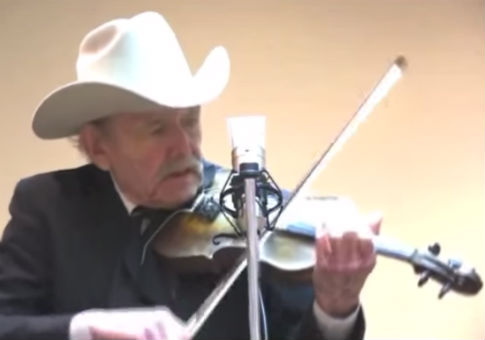Maybe the secret to a good life is being good at more than one thing. Having another string to your bow, as they used to say. Oh, and having money, too, probably helps: just enough that income isn’t your first thought when pursuing an interest. But, really, the older I get—the wider my acquaintance grows and the more obituaries I read—the more I think that the enjoyable lives are the ones neither focused too narrowly nor scattered too broadly. Happiness is a fickle, unlikely thing, of course. Ain’t no one but the Shadow knows what really passes in the heart. Still, the fun lives, the ones I find myself admiring and envying, seem to share a shape—a common pattern across their differences. And that shape usually involves a mild multiplicity and a fine interest in the variances of the world.
This spring, on April 24, a man named Benjamin F. Logan Jr. died at his home in Madison, New Jersey, at age 87. He had been an engineer of some renown, in the circles that offer renown to engineers, and served as a research mathematician at Bell Labs from 1956 till his retirement in 1993. He came out of the electrical engineering program at Texas Tech, moving east to earn a master’s degree from MIT and a doctorate from Columbia. Fascinated by communication theory and practice, he wrote a dissertation on the properties of high-pass signals and was (in 1965) an early user of computers to simulate the reverberation of sound—work that would prove vital in the later digitizing of music. The co-inventor of "colorless" artificial reverb and (notes Mark Liberman) creator of "an important theorem about ‘information in the zero crossings of bandpass signals,’" Logan aided in grounding the electronics of recording in the science of acoustics. Along the way, he patented an echo canceller for satellite communications and worked on the "Shepp-Logan phantom," which helps render images in cranial CT Scans.
And also along the way, he played a little music. You’ve probably seen a video with him in it, at some point: a talking head in a documentary or a background player on an all-star stage. That is, you’ve probably seen him if you follow bluegrass, for Tex Logan was a figure of some renown, in circles that offer renown to bluegrass fiddlers.
In truth, he was one of those bluegrass players more admired by his fellow musicians than by general audiences—which he realized early enough that he gave up working in traveling bands and went back to finish up his degrees. But, man, could he play. The son of musician, Logan was trained on the classical violin, but it was the fiddling that always attracted him.
During his first efforts at playing professionally, he had grown close to Bill Monroe, one of the grandfathers of popular bluegrass, and Monroe would drive over to visit whenever he performed near the large house in New Jersey that Logan’s patents allowed him to buy. It was those visits that prompted Logan to begin hosting in the late 1950s his regular bluegrass parties—and very quickly the all-night festivals became one of the most sought-after invitations in the business. Established players would bring along the youngsters they admired, and it’s not too much of an exaggeration to say that the "newgrass" of the late 1960s and 1970s was, if not born there, then at least weaned at Logan’s parties—on the booze, cigarettes, and fingerpicking that went on till dawn.
Logan’s own songs have been recorded by the likes of Emmylou Harris, Jerry Garcia, and Bob Dylan—although his most often-performed song is probably "Christmas Time’s a-Comin.’" It’s not an entirely typical work, popular in part because bluegrass just doesn’t offer many Christmas songs. Besides, it’s a relatively slow song—by Tex Logan’s standards. He was trained up in the breakdown tradition of Bill Monroe, Lester Flatt, and Earl Scruggs, and the appreciation of his fellow musicians came from the fact that he was so fast. Unbelievably, sometimes unbearably fast: a lightning streak through the breakdown of a bluegrass song.
There’s a great 1969 recording of Bill Monroe calling Tex Logan up to the stage to play "Katy Hill." It opens with Monroe telling Logan that they’ll do the song "however you want to play it," to which Logan replies, naturally, "Let’s play it fast." So Bill Monroe & the Blue Grass Boys play a few chords, to get the tempo going, but Logan doesn’t join in. And when they die away, he starts tapping his foot in a staccato half again the speed they’d had. "Real fast," he tells the band, launching into a rip through the song, the tempo nearly breaking Monroe’s fingers on the mandolin.
Logan always dressed Texas-style for his bluegrass—or Texas-style, at least, as the Grand Ole Opry insisted on Texas: kerchief tie, hat, boots, and pastel suits. The result was a measurable distance from the tweed jackets, button-down-collared shirts, and thin ties of his fellows at Bell Labs. Only the mustache seemed to travel between the two. The mustache and the man himself, of course: Benjamin F. Logan Jr., an engineer working on bottling the lightning of electricity, and Tex Logan, a bluegrass musician who bottled another kind of lightning on the neck of a fiddle.
And why not? Out in a little mid-Texas town—Coahoma, population 900 or so—a smart boy realizes he’s good at math and science, and down that road lies an absorbing and successful career. But out in that same mid-Texas town, a quick boy realizes he’s also pretty good at playing the fiddle. And the wise man, into whom those boys grow, finds a way to use both his talents in interesting ways: always having a second string to his bow as he passed through life.
